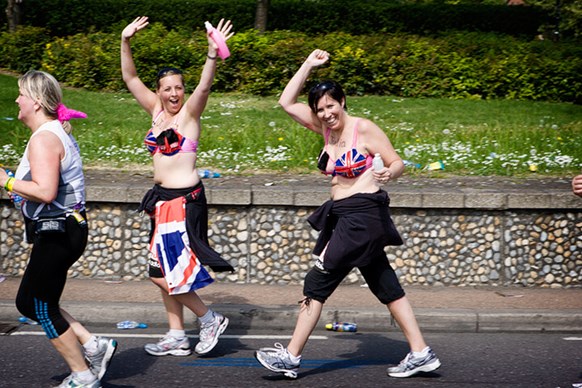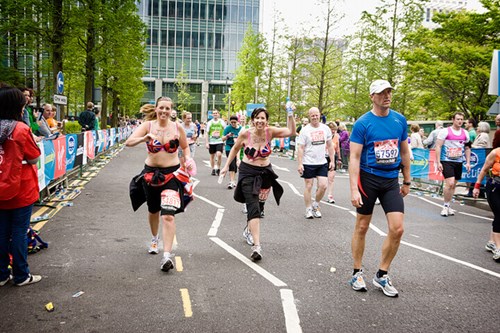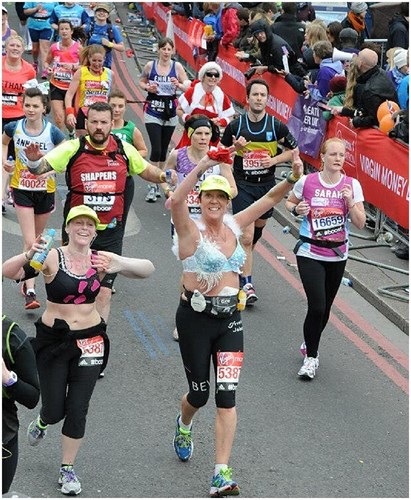Why Walking the London Marathon is Miles Better Than Running It
But their jaws would drop when I told them that, mile for mile, a Power Walker moving at 4.5 miles per hour burns the same calories as a runner.
If you or someone you know has any symptoms that might be linked to breast or other cancers, don’t wait, visit your doctor now!
If you or someone you know has any symptoms that might be linked to breast or other cancers, don’t wait, visit your doctor now!
But their jaws would drop when I told them that, mile for mile, a Power Walker moving at 4.5 miles per hour burns the same calories as a runner.

On the 23rd April 2017 around 35,000 people will flock to our capital to take part in the Virgin Money London Marathon! It’s one of the biggest races of its kind in the world and it’s become part of our national psyche. Millions of us will gather round our TV sets to watch the superhuman athletes, the local running club heroes and those crazy, wonderful people who run (and limp, hop and hobble) in ever more outrageous costumes.

Ask anyone who has made a bucket list and, more than likely, the words run the London Marathon will be on it.
I have a huge respect for the people who do the training and complete the race. The dedication and discipline it takes is amazing... I know, I’ve done it, but that doesn’t change the fact that it’s better for you to walk the Marathon than run it.
I’ll admit I’m biased. I’m really not one of life’s runners. I love sport, I’m very active but I don’t think I’m built to run, it just doesn’t feel right for my body and I’ve never really enjoyed it. I have friends who wax lyrical about the powerful endorphin rush you get when you finally hit your stride, but I get that with Power Walking and for the benefit of my body, have no desire to push myself through the running barrier. However, bias or not, walking the course is still miles better for you than running, and here’s why:
Get a group of runners together in a pub and they’ll start comparing injuries - the dodgy knee, the shin splints, the ankle that might never be the same again. Nearly 70% of runners will become injured at some point.
Power Walking is like running up to a point, in as much as it works the calves, hamstrings, glutes, shoulders and core, but unlike running it also works on your entire body. The way you use your muscles is completely different - walking is low impact and by following a regular training plan, will build muscle tone, stamina and fitness quite quickly without you even noticing, but at an even pace, and without going through a pain barrier. Walking elongates and stretches out the muscles, whereas running shortens them, and there’s no continual pounding on the knees and ankles, which means much less chance of injury.
This might not sound so cool in the pub - but then you won’t be in the pub, you’ll be out walking!
In the early days of my charity Walk the Walk, I’d tell people I’d done the London Marathon and they’d immediately ask what my time was. When I told them I’d Power Walked it, they’d suddenly look a lot less impressed. “Oh,” they’d say. “Walking.” As if 26.2 miles was their idea of a nice little stroll through London!
But their jaws would drop when I told them that, mile for mile, a Power Walker moving at 4.5 miles per hour burns the same calories as a runner. And if you push yourself up to five miles an hour - which is achievable with good technique - you actually start to burn more calories than you would running.

At the start of the marathon we walkers have to keep to one side while hoards of enthusiastic runners surge forward like a bull out of a gate. But chances are that many of them will be doing a walk-run, walk-run combination and end up doing neither too well. As I said, their training would have shortened their calf muscles so when they start to stretch them as they walk... not good.
With walking if you set off at one speed - a little below your maximum ability so you have something stored up if you need it - you’ll be aiming to walk at the same constant pace until mile 26. You soon start to overtake some of the slower or more unprepared runners. Our teams are so consistent that often runners that are running alongside us, will use us as pace-setters.
On Marathon day, the crazy crowds and all those weird and wonderful costumes make it fun and special for everybody, but you can still spot the Walk the Walk team a mile away and not only because of the decorated bras! There’s a buzz about our team as they chat and sing their way around the course.
Many runners are dedicated and commit to their training but there will still be thousands of people that haven’t trained properly and will find themselves dropping out of a run and fighting exhaustion. Power Walking still requires a commitment to training but it allows anybody to reach their full potential. It’s just as much of a challenge to Power Walk the course as it is to run but walkers do seem to have smiles on their faces all the way round - you can’t help it when you are wearing a customised bra!
So many people treat the London Marathon as a once-in-a-lifetime thing. They train hard, they complete the course and then tick it off their bucket list. Others give up running due to injury or just simply as they get older. But walking is a sustainable sport which you can take into your 80s or 90s and beyond. A fitness habit you can keep for life.
Until I started Walk the Walk, I never associated walking with marathons but you can still be a part of this big day without breaking into a run, and every year many people do - from the hard core race walkers (who can achieve speeds of up to nine mph!) to our team of enthusiasts. We send teams to the Dublin, Berlin and New York City marathons too. There’s nothing like being part of an event that big - the atmosphere is amazing and the crowd is so supportive. And, whether walking, running or wheeling, everyone who crosses that finish line is a hero. I salute every last one of them.
Nina x
Founder and Chief Executive of Walk the Walk
Tempted to join us? Apply for one of our limited Charity places for 2017 and we will be in touch.
Comments